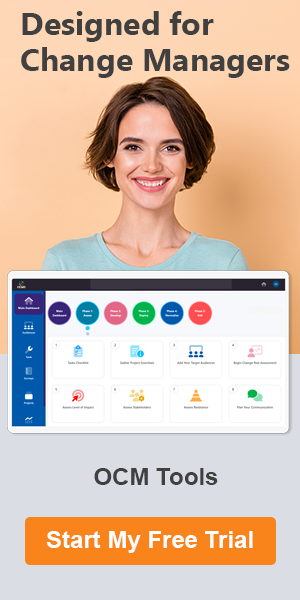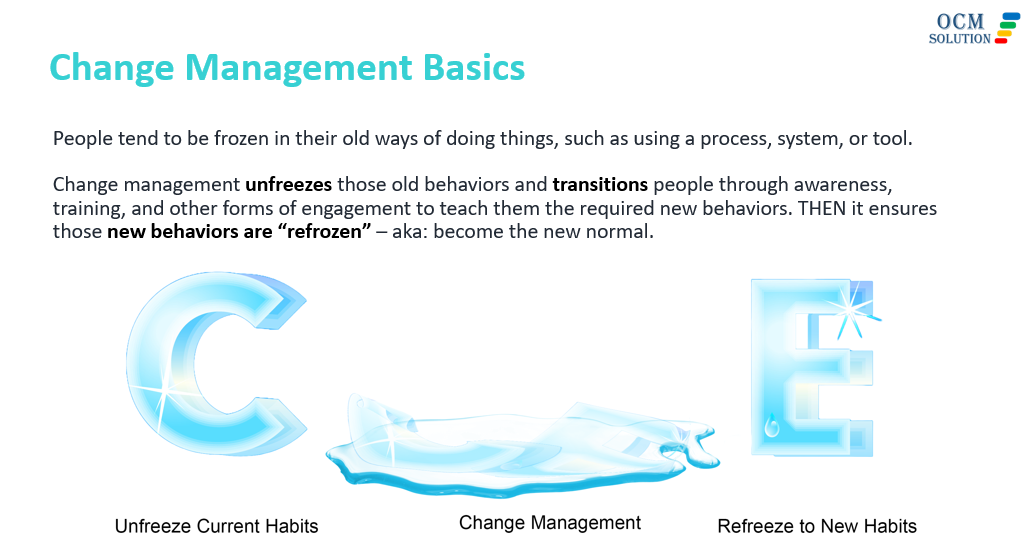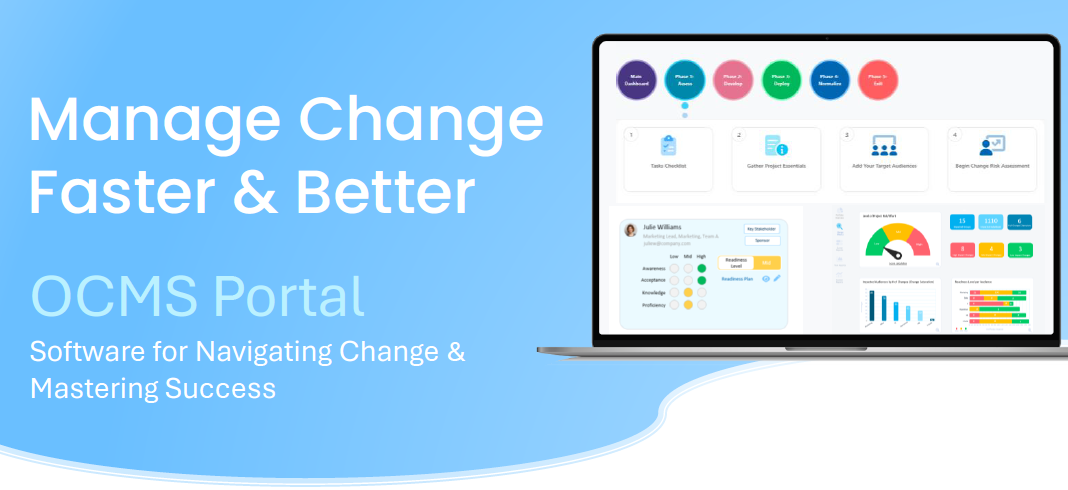Choosing the Right Change Management Model for Your Organization
Below, we’ll explore some of the most popular OCM frameworks used by organizations worldwide.
We’ll look at the Prosci ADKAR model, which focuses on individual change, the McKinsey 7S framework that examines organizational elements, and Lewin’s change management model, one of the earliest and most influential approaches. We’ll also touch on Kotter’s 8 Step model for change, OCM Solution’s 4-phase framework, and others.
Whether you’re rolling out new software, restructuring departments, or adopting new business strategies, understanding different change management models, such as ADKAR, Lewin’s model of change, the OCMS change framework, or Kotter’s 8 step change model, can make the transition smoother.
Trying to successfully transform an organization from the current state to a future desired state without a framework for the change process, is like trying to navigate a ship without a rudder. You often end up off target.
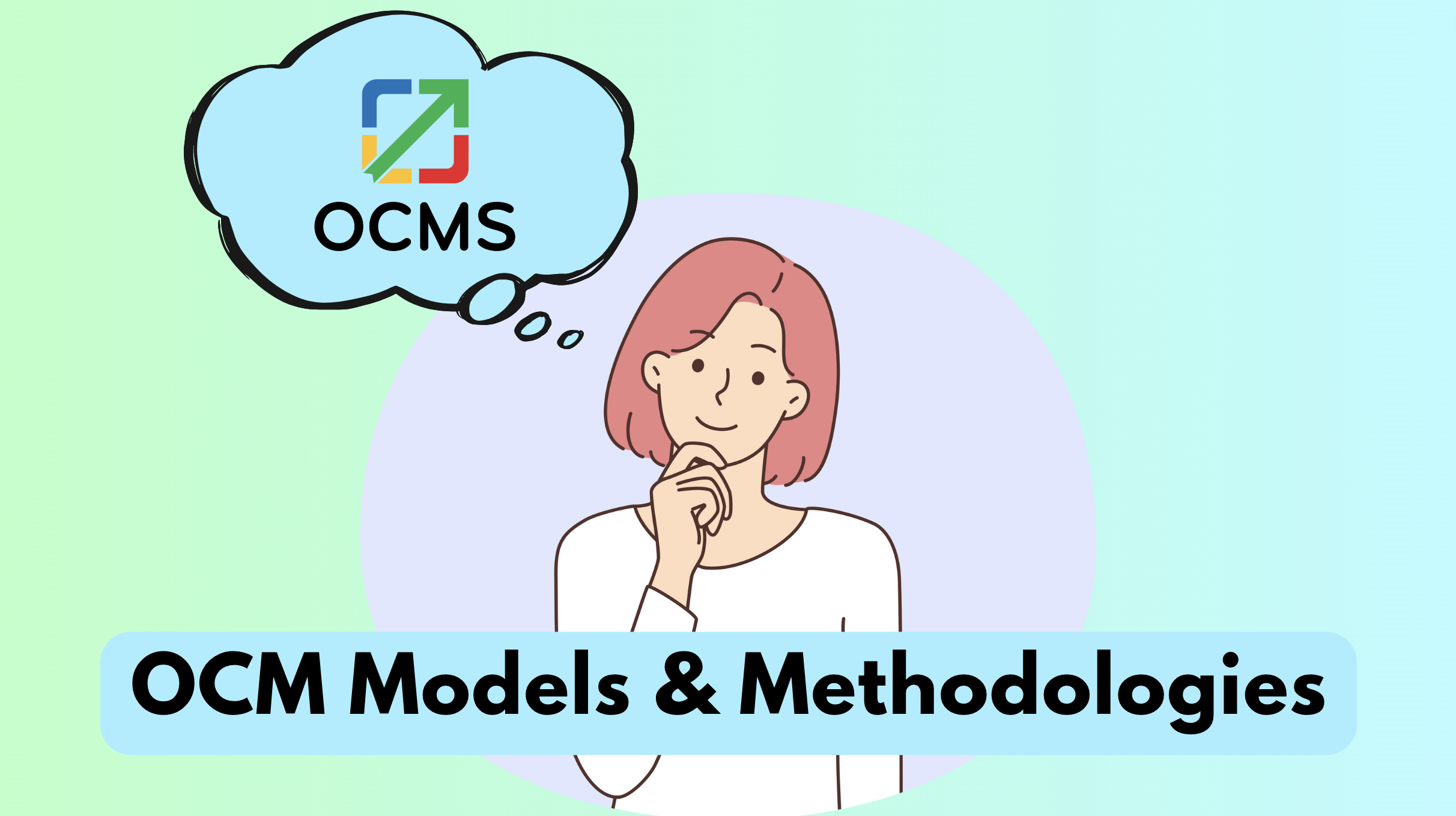
A change management model is a structured approach designed to help organizations adopt and sustain changes. These OCM models provide guidelines, processes, and tools to manage the people side of change, ensuring that the changes are implemented smoothly and successfully. They address various aspects of change, such as planning, communication, training, and support, to minimize resistance and maximize engagement and adoption.
What is the benefit of using a change management model?
Using a change management model offers several key benefits:
- Clear Guidance: It provides a step-by-step approach, making it easier to plan and execute change initiatives.
- Consistency: Ensures that everyone involved follows a consistent process, reducing confusion and miscommunication.
- Minimized Resistance: Helps identify and address resistance to change early on, increasing the likelihood of acceptance and support.
- Increased Efficiency: Streamlines the change process, saving time and resources by avoiding unnecessary trial and error.
- Improved Outcomes: Enhances the chances of achieving desired outcomes by applying proven methodologies and best practices.
Story Highlights
|
Understanding the Options for Organizational Change Management Methods
There are various organizational change management methods available to help implement and manage changes within an organization. Consulting firms like Deloitte, Accenture, and McKinsey have their own change management models, and there are also standardized methodologies such as the Prosci ADKAR change model, Accelerating Implementation Methodology (AIM), Kurt Lewin’s change management models, John Kotter’s change model, Kübler-Ross’ change curve, Bridges’ transition model, and others.
However, not all change management methods are equal. Organizations typically have limited resources and budgets for major transformational initiatives. Therefore, it’s crucial to focus on strategies that provide the maximum impact in the shortest time. The key is to continuously assess and weigh the impact and risks of various activities on the individuals affected by the change.
When selecting a change management model or method, it’s essential to consider the severity, scale, and magnitude of the impacts on the people involved in the change program. This consideration is vital to ensure that the chosen approach is the most suitable for your organization and the individuals impacted by the change.
Change Management Models & Frameworks Overview
Top organizational frameworks and models of change process offer structured approaches to managing and navigating the complexities of organizational change. These methodologies provide tools and insights to ensure successful transitions and while choosing the right model is essential to address an organization’s specific change management needs, selecting the right one can often be a challenge.
Here is a brief look at the top change models and methodologies and their key characteristics:
- Accelerating Implementation Methodology (AIM): A flexible, data-driven change management model suitable for various transformational programs, offering integrated strategies, tactics, and tools.
- APMG Certified Change Management Professional™ (CCMP™): A globally recognized certification based on generally accepted change management practices and processes, not tied to a specific change model.
- Bridges Transition Change Management Model: The William Bridges Transition Model emphasizes the personal journey through change, focusing on the transition individuals go through to successfully transition to a future state.
- Change Curve Model: The curve of change model was originally derived from the Kübler-Ross Change Curve® which was developed to show how people move through grief. It shows the curve of emotions that people feel as they initially are shocked by a new change, and then eventually come to integrate it into their day-to-day.
- John Kotter’s Change Method and Theory: Kotter’s 8 step model for change focuses on generating enthusiasm, especially within leadership, and provides a roadmap for initiating, managing, and sustaining change.
- Kurt Lewin Change Management Model: Lewin’s model for managing change is a 3-stage process that focuses on the transitions needed by individuals impacted by change and compares them to the freezing and unfreezing of water.
- McKinsey 7-S Change Model: The 7s McKinsey model is a holistic framework that examines various elements of a company’s structure and culture to ensure they are in harmony for successful change management.
- OCM Solution Change Management Method: Developed by Ogbe Airiodion, this change management framework has four phases and addresses the limitations of the Prosci and ADKAR approach and focuses on a “manage by deliverables” process.
- Prosci ADKAR® Change Management Model: A highly regarded model known for its flexibility and goal-oriented approach, with five key milestones (Awareness, Desire, Knowledge, Ability, and Reinforcement) to guide individual and organizational change.
These models and methodologies offer different approaches and can be applied depending on an organization’s specific needs and goals for managing change. Keep reading for a deeper explanation of these change management models.
Do you have any questions about the ADKAR framework, Kurt Lewin’s change management models, the Kotter 8 Step model, the Change Curve, or other OCM methodologies? Please reach out and let us know!
Why Use Change Management Models? My Experience as a Sr. Change Management Lead
Why use organizational change management models? What are the true benefits of applying an OCM methodology?
Over the last few decades, I have implemented large-scale organizational changes across Intel, Deloitte, Apple, Cisco, the U.S. Federal Reserve Bank, State Street, Accenture, HSBC, Capital One, and other global organizations. During my tenure, I have had the opportunity to apply most of the change management models presented in this article.
Time and time again, I have identified that applying a structured, defined, and flexible change management methodology increases the success of projects by over 91%.
Leverage this article, as well as the scholarly articles for change management methodologies referenced below to help increase your knowledge and change performance. Message us if you have any questions.
Ogbe Airiodion
Senior Change Management Lead & Consultant
Best Change Management Methodologies and Models for This Year and Beyond
Click through the list of change management methodologies below to view details on that model:
- Accelerating Implementation Methodology (AIM)
- APMG Certified Change Management Professional™ (CCMP™) – UK
- Bridges’ Change Management Framework
- Change Curve Model
- John Kotter’s OCM Methodology
- Kurt Lewin Change Model
- McKinsey 7-S Change Model
- OCM Solution Change Model
- Prosci Change Management Methodology (ADKAR)
Best Change Management Methods for Specific Industries
The list of change frameworks and methodologies below includes models that are best suited for specific industries & sectors:
- Change Management Framework for the Healthcare Sector
- Change Management Model for the Nursing Sector
- Change Model for Healthcare Industry
- Change Processes for Education Institutions
- Top Framework for Improving Leadership in Healthcare & Social Care
- Top Frameworks for Transformational Leadership in Schools
- Transformational Leadership in Nursing Practices
Please let us know if you have any questions or feedback about Kurt Lewin’s model for managing change, Prosci’s ADKAR model, the OCMS change management framework, the McKinsey 7s model, Kotter’s 8 stage change model, the Change Curve, or other OCM methodology (organizational change management methodology).
High-Level Review:
Top Organizational Change Models and Methodologies
Accelerating Implementation Methodology (AIM) Change Method
The Accelerating Implementation Methodology change model is a flexible, business-disciplined change management framework that is both systematic and systemic.
The AIM change model is driven by data, which increases its appeal to the sciences and technology sector as well as to human resources (HR) professionals.
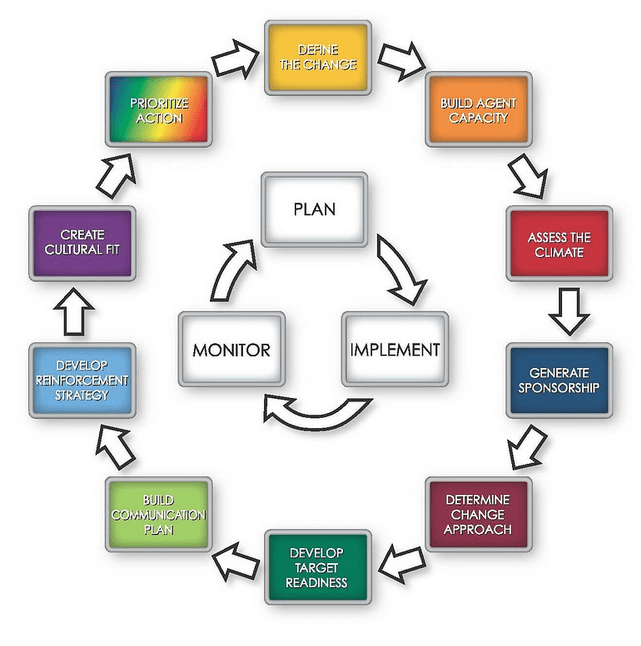
Based on its flexible structure, the AIM change method can be applied to any kind of transformational program, from small to large scale initiatives, which makes it one of the top models of change management.
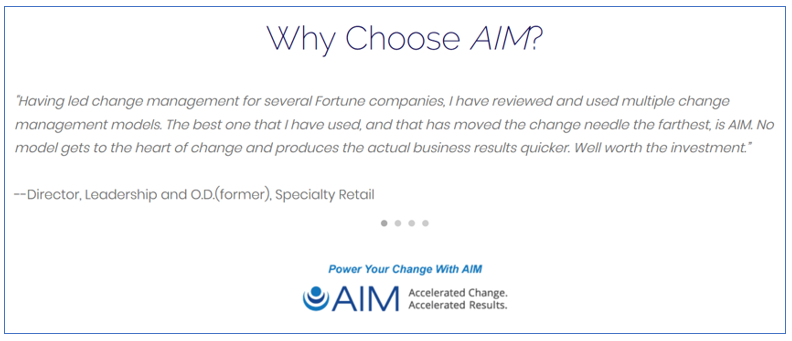
A key benefit of the AIM organizational change management model is that it involves an integrated system of operationalized strategies, tactics, techniques, analytics, and tools that can be applied across the life cycle of a change program, all the way from inception through the “post-implementation phase” where the return on investment is realized.
Questions or comments about the AIM change method or change management methodologies and tools? Click here to contact the OCM Solution Change Management Team.
APMG Certified Change Management Professional™ (CCMP™)
ACMP’s globally recognized change management specialist certification is based upon the organization’s Standard for Change Management©. Becoming a Certified Change Management Professional™ (CCMP™) carries a lot of weight in the change management world.
After developing a set of standards, ACMP launched its CCMP certification 2016. In a fairly short amount of time, it’s gained worldwide recognition as a top change management certification online or offline.
The APMG CCMP certificate is accredited by the United Kingdom Accreditation Service (UKAS) for Change Management Practitioner certification. UKAS is the UK’s only Government recognised National Accreditation Body – responsible for assessing the competence of organizations providing professional certifications. As such, if you are based in the UK, the CCMP certificate might be your go-to certificate of choice.
What Model is Taught for CCMP Certification?
The CCMP certification is “method neutral.” This means that it doesn’t teach a specific change model, like some other organizational change management certification programs. The Certified Change Management Professional™ (CCMP™) covers generally accepted practices and processes used across multiple industries.
Read more: APMG Certified Change Management Professional™ (CCMP™) – UK
Questions or comments about the APMG Certified Change Management Professional™ (CCMP™) or change management principles and methodologies? Click here to contact the OCMS Solution Change Management Team.
Bridges’ Transition Change Management Model
When you’re facilitating change in any organization, you have to focus on the planning element as well as understand how that change will impact your employees and other stakeholders.
If your change planning is too “top-heavy” and doesn’t focus enough on the people transitioning through the change, you have a good chance at failure.
One of the most effective change management models that is all about the personal journey through change is the William Bridges transitions model for change. The personal journey is at the heart of the William Bridges transition model.
William Bridges’ organizational change model argues that instead of focusing on the change itself, the focus should be put on the transition that people have to go through for the change to happen successfully. Read more: How Do You Use Bridges’ Transition Model to Facilitate Change? Pros & Cons.
Questions or comments about the Bridges’ change framework or organisational change management methods or other change management methodologies and tools? Click here to contact the OCM Solution Change Management Team.
Change Curve Model
The Change Management Curve Model, derived from Elisabeth Kübler-Ross’s work on grief, outlines the emotional stages individuals experience during organizational change. These stages include shock, denial, frustration, depression, experiment, decision, and integration. Understanding this model helps leaders anticipate and address the emotional responses to change, providing targeted support and strategies at each stage to facilitate a smoother transition and improve overall outcomes.
The curve of change framework emphasizes that each stage requires different leadership responses to support employees effectively. During the initial stages of shock and denial, clear communication and reassurance are crucial. As employees move through frustration and depression, empathy and support can help them cope with their emotions. In the experiment and decision stages, providing training and resources encourages adaptation. Finally, during the integration stage, recognizing achievements and reinforcing new behaviors solidifies the change, ensuring long-term success and organizational resilience
Do you have any questions about the change curve or how to use it with other OCM methodologies? Please reach out and let us know.
John Kotter’s Change Method and Theory
Why is John Kotter’s 8-Step change management model so popular?
The Kotter 8-step change management framework is very popular because it offers an easy-to-understand roadmap that change managers can follow, even if they’re new to change. Each step describes exactly what needs to happen to keep a change project on track.
John Kotter’s 8-step change framework focuses on the enthusiasm that one must generate, especially within the firm’s leadership, to make change happen. It lays out eight key transitional steps that take you through the process of initiating, managing, and sustaining change.
Looking at the pros and cons of Kotter’s change model is an excellent way to decide if it’s a good fit for your change team and organizational needs. You don’t want to just jump in and choose the first change model you run across; otherwise, you could end up having problems. Read more: Detailed Review: John Kotter’s Change Management Model.
Questions or comments about the Kotter organizational change management model or other change management methodologies? Click here to contact the OCM Solution Change Management Team.
Kurt Lewin Change Management Model
Kurt Lewin is often recognized as one of the pioneers of social psychology. He emigrated to the U.S. from Germany and is the person behind Lewin’s three-stage model for change management.
The Kurt Lewin model of change management includes a 3-stage process that many companies find simple to understand and implement. It’s one of several change management frameworks that organizations can use as a roadmap for change.
Lewin’s 3 stage model of change focuses on the transitions needed by people that are impacted by a change, comparing them to the freezing and unfreezing of water, and is designed to move an organization’s team past initial signs of resistance.
Visualization based on Lewin’s Change Model (Unfreeze – Change – Refreeze)
How do you know if Kurt Lewin’s organizational change methodology is the best one for your change project? What are the cons and pros of this change methodology? Read more: Kurt Lewin Change Model | Pros & Cons | Everything You Need to Know.
Questions or comments about the Lewin change methodology model or the OCMS change management methodology? Click here to contact the OCM Solution Change Management Team.
McKinsey 7-S Change Model
Companies have multiple moving parts that can be impacted by a change. Even the smallest change can set off a ripple throughout an organization. Understanding all the pieces of business that can be impacted by the change is at the heart of the McKinsey 7S framework.
The 7S model, that McKinsey introduced back in the late 1970s takes a holistic look at what makes companies tick and how each element of a company needs to be in harmony for an organization to operate competitively and manage change successfully.
Click below to find out how the McKinsey 7S OCM methodology is used for organizational analysis and in change management projects. Bonus: We included a downloadable McKinsey 7S framework PPT and McKinsey 7S framework PDF that you can use to explain this McKinsey change management method to others.
Read more: McKinsey 7S Change Model Framework | All You Need to Know.
Questions or comments about the 7S change process and model or other change management methods? Click here to contact the OCM Solution Change Management Team.
OCM Solution Change Management Method
The OCMS change management framework provides a structured approach to managing change within an organization. It emphasizes a holistic strategy that includes assessing readiness, aligning change initiatives with business objectives, and ensuring stakeholder engagement throughout the process. The framework outlines essential phases such as planning, implementation, and sustainability, each with specific tools and techniques to guide organizations through transitions effectively. This comprehensive approach ensures that changes are not only implemented but are also sustainable, minimizing disruption and maximizing benefits.
A key aspect of the OCMS framework is its focus on communication and training. Effective communication strategies are developed to ensure that all stakeholders are informed and engaged, reducing resistance and fostering a culture of support for change. Training or support programs are tailored to equip employees with the necessary skills and knowledge to adapt to new processes and systems. By integrating these elements, the OCMS change management framework helps organizations navigate change smoothly and achieve long-term success.
Read more: Best Change Management Framework for Change Managers and Teams
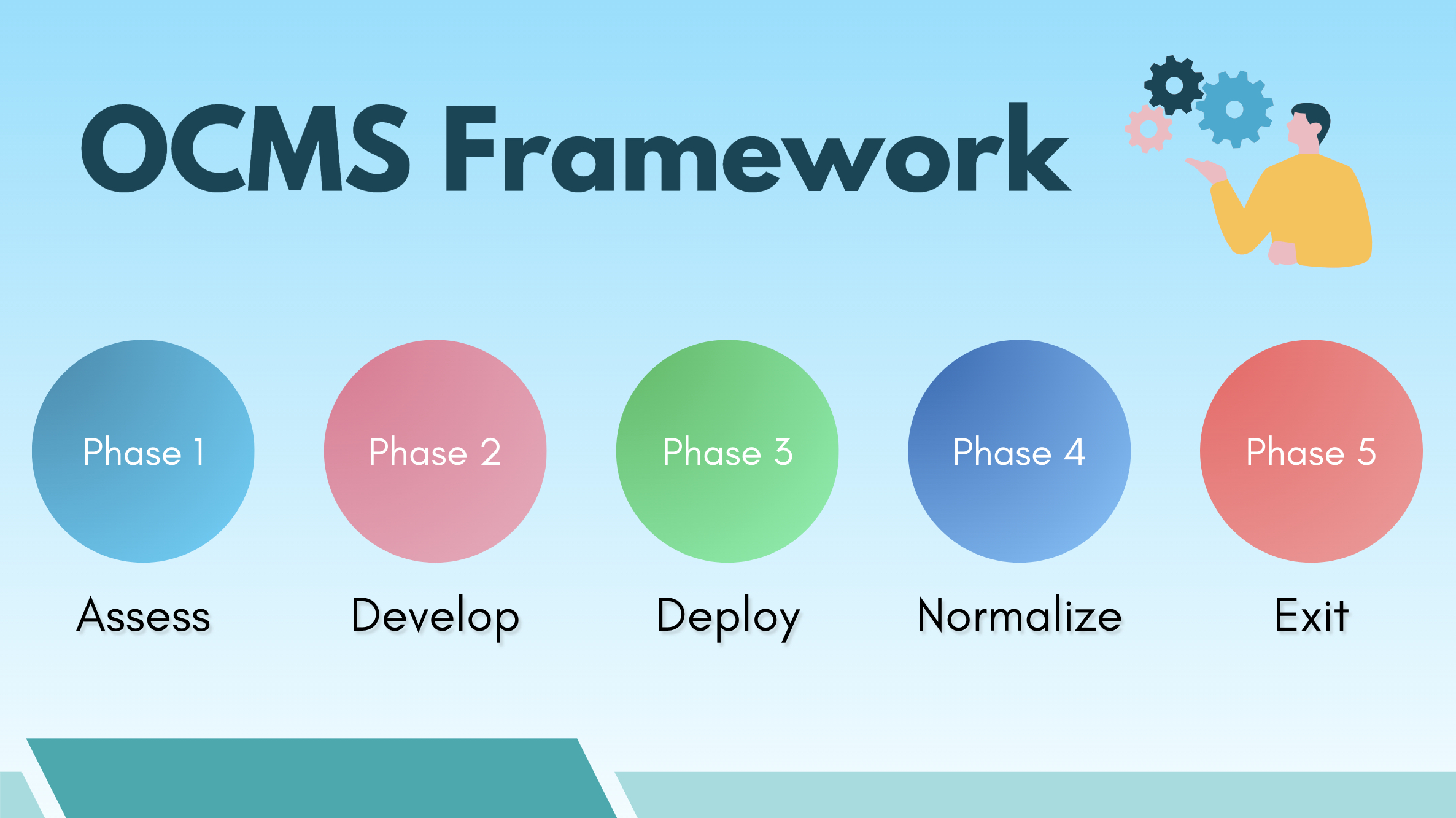
Questions or comments about the OCM Solution change model or the change management processes and methodologies? Click here to contact the OCM Solution Change Management Team.
Prosci ADKAR® Change Management Model
The Prosci ADKAR® Model is often considered one of the best change management methodologies by organizations across every industry. This is due to the ADKAR change management model’s flexibility and goal-oriented framework that guides individual and organizational change.
The Prosci ADKAR® Model is a goal-oriented change framework that was created by Jeff Hiatt, Prosci’s founder. ADKAR is an acronym that represents five key milestones that users need to achieve for lasting change.
In spending decades studying change leaders and programs, noting what worked and what didn’t, and establishing how to effectively implement change and measure results, Prosci has been able to create a repeatable, scalable change management method for managing the people side of change.
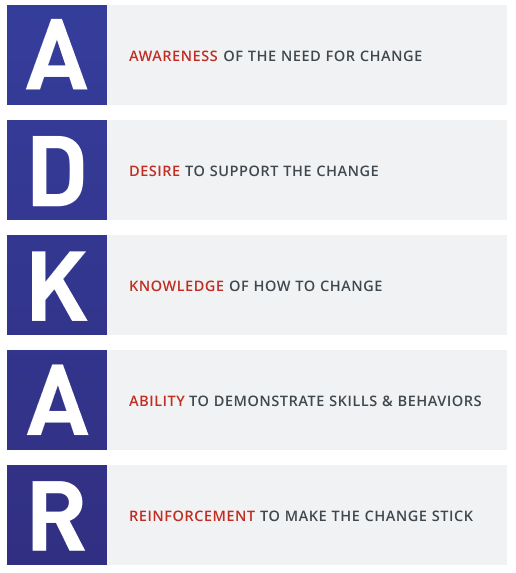
When an organization implements a new solution, it is the employees and managers who eventually need to learn and use the new solution. If individuals are not successful in their individual transformations, then the solution will not achieve success.
The ADKAR OCM methodology has become one of the widely used top change management models because it is structured specifically for transiting the individual employee, which makes it a great change model for:
- Planning change management activities
- Diagnosing gaps
- Developing corrective actions
- Supporting managers and supervisors
Please let us know if you have questions about the ADKAR framework or other change management processes and methodologies.
Would you like to get change management advice based on best practices and practical change management tips delivered to your inbox monthly? Sign up for our OCMS Portal Newsletter.
OCMS Portal – Software Designed for Change Management Models
OCMS Portal is designed around a simple change management framework, but it’s also flexible to use with the Prosci ADKAR model and others. This all-in-one change management platform includes tools for all the critical components of successful change management, including change impact and stakeholder analysis, communication planning, change readiness, and impact analytics.
Empower your team with tools that walk them through a proven process of change management and gain visibility into change through your organization like never before.
Don’t Miss.
Scholarly articles for change management methodologies and other related business change process:
- Do You Really Need a Change Mgt Certification? Is it Worth it?
- Prosci Change Management | All You Need to Know
- Prosci ADKAR Change Management Model
- Kurt Lewin Change Model | Pros & Cons
- Change Management Career Path & Salary | All You Need to Know
- Review of Prosci’s Change Consultancy | What You Need to Know
- John Kotter’s 8-Step Change Model | Pros & Cons
- McKinsey 7S Model Framework
- Change Management Training | Employees & Leaders
- Adapting to Change in the Workplace
- Importance of Change Management in an Organization
- The Best Guide for Overcoming Employee Resistance to Change
- HR’s Role in Change Management Success
- Top Guide for Managing Resistance to Change in an Organization
- Applying Best Change Management in Healthcare | All You Need to Know
- Should You Spend $4,400 for a Prosci Certificate? Is it Worth it?
- Implementing Change Management in the Workplace
- Best Ways for Leading a Team Through Change in the Workplace
- Change Management Career Path & Salary
- Review of Prosci’s Change Consultancy
- Top 10 Best Change Management Consulting Firms for Consultants
- Finding the Best Change Management Jobs
- Business Change Manager | Roles, Jobs, Training
- The Best Practices for Changing Organizational Culture in Healthcare
- Best Change Management for Nursing
- What Does a Change Manager Really Do?
- Change Management Consultant | Pay Rates, Getting In & More
- Change Management in Project Management
- Change Management Benefits & Importance
- Top Guide to Best ITIL Change Management Processes & Practices
- ITIL Certification, Exam Cost, Test Questions
- Change Management vs Project Management
- Change Management Project Manager | Pay Rates & More
- The Best Ways to Manage, Deal, and Cope with Change at Work
- Bridges’ Transition Model for Change | All You Need You Know
- Prosci Change Management | All You Need to Know
- Prosci ADKAR Change Management Model
FAQ – Popular Change Management Methodologies
A change management methodology is a defined and structured process for implementing organizational change management. It outlines the steps you need for completing the three key stages of an organizational change management program.
The different change methods include: Accelerating Implementation Methodology (AIM), the OCM Solution Change Management Framework, Bridges’ Transition Change Management Framework John Kotter’s OCM Methodology and Theory, Kurt Lewin Change Model, McKinsey 7-S Change Model, the Change Curve, and Prosci Organizational Change Management Methodology (ADKAR). There are other change management principles and methodologies, but these are the most popular and well known.
The Lewin's 3 stage model focuses on the transitions needed by people that are impacted by the change, comparing them to the freezing and unfreezing of water. Kurt theorized that to begin a successful change project, people need to be jolted out of their current equilibrium so they can transition to the new state of being, which is the post-change state or desired state. Read more at: https://www.ocmsolution.com/kurt-lewin-change-model/
The Kotter 8-step model is popular because it offers an easy-to-understand roadmap that change managers can follow, even if they’re new to change. Each step describes exactly what needs to happen to keep a change project on track. John Kotter’s 8-step model focuses on the enthusiasm that one must generate, especially within the firm’s leadership, to make change happen. It lays out eight steps that take you through the process of initiating, managing, and sustaining change. Read more at https://www.ocmsolution.com/john-kotter-change-model/
The key elements of a successful change management program includes leadership support, effective communications, a completed change impact assessment, successful training and enablement and ongoing reinforcement of the change.What is a change management methodology?
What are the different change management methodologies?
What is Lewins 3 Step Model?
What is Kotter Change Model?
What are the 5 key elements of successful change management?
Note: Content on OCM Solution's ocmsolution.com website is protected by copyright. Should you have any questions or comments regarding this OCM Solutions page, please reach out to Ogbe Airiodion (Change Management Lead) or the OCM Solutions Team today. OCM Solution was previously known as Airiodion Global Services (AGS).
External sources: https://www.prosci.com/adkar/applications-of-adkar, https://www.imaworldwide.com/aim-change-management-methodology, https://www.imaworldwide.com/blog/the-value-of-aim-change-management-certification



